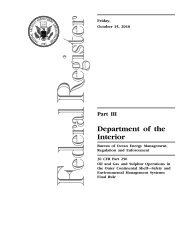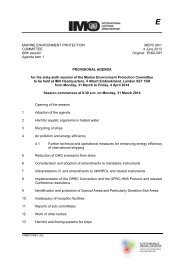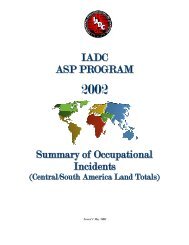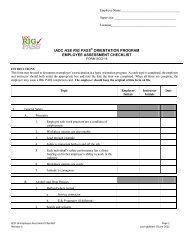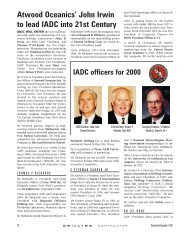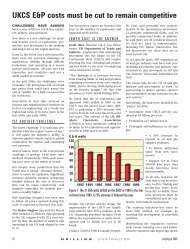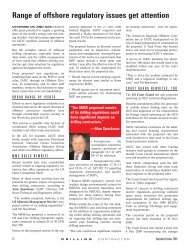IADC HSE Case Guidelines for Land Drilling Units - Issue 1.0.1
IADC HSE Case Guidelines for Land Drilling Units - Issue 1.0.1
IADC HSE Case Guidelines for Land Drilling Units - Issue 1.0.1
Create successful ePaper yourself
Turn your PDF publications into a flip-book with our unique Google optimized e-Paper software.
<strong>IADC</strong><br />
<strong>HSE</strong> <strong>Case</strong> <strong>Guidelines</strong> Part 2 – <strong>Land</strong> <strong>Drilling</strong><br />
How can this be achieved?<br />
‣ Requiring that a task plan, with an appropriate level of risk assessment, is developed <strong>for</strong><br />
all work activities.<br />
‣ Monitoring of the work activities to ensure they are planned and risk assessed and that<br />
the plans are followed.<br />
‣ Developing and implementing Rig specific procedures which enable the organisation or<br />
Rig to identify hazards, assess risks and establish controls to ensure that the risks are<br />
tolerable to the <strong>Drilling</strong> Contractor.<br />
‣ Applying the procedures as appropriate <strong>for</strong> all routine and non-routine activities and<br />
operations involving client and third-party representatives.<br />
What in the <strong>Drilling</strong> Contractor’s Management System demonstrates assurance to others that<br />
this objective can be achieved?<br />
‣ Arrangements to ensure task plans with risk assessments are developed <strong>for</strong> all work<br />
activities.<br />
‣ Arrangements <strong>for</strong> the resources necessary to develop task plans are available.<br />
‣ Arrangements <strong>for</strong> supervisors and other line management to monitor work activities.<br />
2.3.2 Management of Change<br />
Objective<br />
To demonstrate <strong>HSE</strong> implications associated with changes in organisation, procedures or<br />
equipment are assessed as part of the change control process.<br />
How can this be achieved?<br />
‣ Applying hazard identification and risk management principles as part of the change<br />
process.<br />
‣ Defining the roles and responsibilities <strong>for</strong> initiating and authorizing changes.<br />
‣ Ensuring open consultation and effective communication with those affected by any<br />
change.<br />
‣ Ensuring that those responsible <strong>for</strong> <strong>HSE</strong> critical/hazardous activities accept and take<br />
ownership of any changes to those activities.<br />
What in the <strong>Drilling</strong> Contractor’s Management System demonstrates assurance to others that<br />
this objective can be achieved?<br />
‣ Description of the change management procedures.<br />
2.3.3 Emergency Response (Overview)<br />
Objective<br />
To demonstrate that emergency plans and arrangements are in place to provide effective<br />
response to all reasonably <strong>for</strong>eseeable emergencies (including environmental incidents).<br />
How can this be achieved?<br />
‣ Identifying <strong>for</strong>eseeable emergency scenarios (See Part 4 Risk Management).<br />
‣ Ensuring that <strong>for</strong> each scenario, emergency plans and procedures are developed and<br />
maintained.<br />
‣ Ensuring the <strong>Drilling</strong> Contractor is able to respond at any time to emergency situations<br />
involving its activities.<br />
‣ Establishing arrangements <strong>for</strong> calling on support from external agencies and resources.<br />
<strong>Issue</strong> <strong>1.0.1</strong> – 27 July 2009 14




